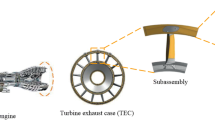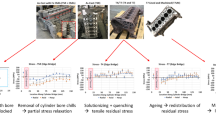Abstract
As the optimization of highly demanding engine parts like engine disks pushes the materials used to their limits, the estimation of the material properties becomes increasingly important. The complex interactions of strengthening mechanisms in direct aged (DA) Alloy 718 forgings demand detailed modeling of each mechanism. As some strengthening mechanisms are influenced during the billet processing it is essential to consider the forging stock manufacturing in the design process of forged engine disks. Therefore, a finite element analysis of the billet processing was incorporated in an existing simulation chain of the closed die forging process of engine disks. It includes all thermo-mechanical operations after vacuum arc remelting, i.e. homogenization , upsetting, drawing and radial forging of the billet as well as prepressing, forging and heat treatment of a disk . In order to implement the local variations of microstructure caused by the billet processing a newly developed grain class model was applied. Furthermore a duplex microstructure , which is often present in the surface region of the billet, was considered using the grain class model. For a sound precipitation modeling the local temperature history of the whole simulation chain was considered in the thermo-kinetic software tool MatCalc. After parameterization of the MatCalc model, parameters for the precipitation , solid solution and grain boundary contribution to the total yield strength was calculated. For the determination of the DA-effect a semi-empirical, deterministic model was developed. The established, automated simulation chain takes all mentioned mechanisms into account and calculates the local yield strength of the forged engine disk .
Access this chapter
Tax calculation will be finalised at checkout
Purchases are for personal use only
Similar content being viewed by others
References
Rivindar Reddy PVRF, Chandra Mohan Reddy G, Radhakrishna Prasad P (2012) A review on finite element simulations in metal forming. IJMER 2(4):2326–2330
Brand AJ, Karhausen K, Kopp R (1996) Microstructural simulation of nickel base alloy Inconel 718 in production of turbine discs. Mat Sci Tech 12(11):963–969
Sommitsch C (1999) Theorie und Modell der mikrostrukturellen Entwicklung von Nickel-Basis-Legierungen während dem Warmwalzen. PhD thesis, TU-Graz
Shen G, Rollins J, Furrer D (1996) Microstructure modeling of forged waspalloy discs. Superalloys 1996:613–620. Warrendale, PA: The Minerals, Metals & Materials Society
http://www.bohler-aerospace.com/english/files/downloads/Folder_aerospace_2015_Druckboegen_web.pdf. Accessed 16 Apr 2018
Wasle G (2003) Cogging–physikalische und numerische Simulation der Primärumformung von Nimonic 80a. PhD thesis, TU-Graz
Stockinger M (2003) Mikrostrukturelle Simulation des Gesenk-schmiedens von Nickelbasis-Legierungen. PhD thesis, TU-Graz
Stockinger M, Tockner J (2005) Optimizing the forging of critical aircraft parts by the use of finite element coupled microstructure modeling. In: Proceeding of the sixth international special emphasis symposium on superalloys 718, 625, 706 & derivatives. pp 87–95. Warrendale, PA: The Minerals, Metals & Materials Society
Liebminger U (2017) Implementation and validation of the duplex grain size model for the manufacturing process of INCONE alloy 718 engine disks. Bachelor thesis, FH Joanneum Graz
Oberwinkler B, Fischersworring-Bunk A, Hüller M, Stockinger M (2016) Integrated process modeling for the mechanical properties optimization of direct aged alloy 718 engine disks. Superalloys 2016:513–521. Warrendale, PA: The Minerals, Metals & Materials Society
Hall EO (1951) The Deformation and Ageing of Mild Steel: III. Discuss Results Proc Phys Soc B 64:747–753
Petch NJ (1953) The cleavage strength of polycrystals. J. Iron Steel Inst 174:25–28
Ahmadi MR, Povoden-Karadeniz E, Öksüz K, Falahati A, Kozeschnik E (2014) A Model for precipitation strengthening in multi-particle systems. Comp Mater Sci. 91(8):173–186
Gypen LA, Deruyttere A (1977) Multi-Component Solid Solution Hardening. J Mat. Sci 12(5):1028–1033
Bucher Ch (2017) Optimierung des Herstellprozesses von Geschmiedeten Turbinenscheiben für optimalen Direct-Age-Effekt unter Berücksichtigung von abnormalem Kornwachstum. Master thesis, Montanuniversität Leoben
McKay MD, Beckman RJ, Conover WJ (1979) A Comparison of Three Methods for Selecting Values of Input Variables in the Analysis of Output from a Computer Code. Technometrics (JSTOR Abstract) 21(2):239–245
Aoki C, Ueno T, Ohno T (2016) Influence of hot working conditions on grain growth behavior of Alloy 718. Superalloys 2016:609–617. Warrendale, PA: The Minerals, Metals & Materials Society
Acknowledgements
The research performed in this paper has been funded by the Clean Sky Joint Undertaking under the European Union’s Seventh Framework Programme under grant agreement No 296526, and it has received funding from the Clean Sky 2 Joint Undertaking under the European Union’s Horizon 2020 research and innovation programme under grant agreement No 714043 as well as by the Austrian Federal Government (in particular from Bundesministerium für Verkehr, Innovation und Technologie and Bundesministerium für Wissenschaft, Forschung und Wirtschaft) represented by Österreichische Forschungsförderungsgesellschaft mbH and the Styrian and the Tyrolean Provincial Government, represented by Steirische Wirtschaftsförderungsgesellschaft mbH and Standortagentur Tirol, within the framework of the COMET Funding Programme.
Author information
Authors and Affiliations
Corresponding author
Editor information
Editors and Affiliations
Rights and permissions
Copyright information
© 2018 The Minerals, Metals & Materials Society
About this paper
Cite this paper
Stockinger, M., Stanojevic, A., Wieser, V., Raninger, P. (2018). Development of an Automated Property Simulation Tool for Direct Aged Alloy 718 Engine Disk Forgings. In: Ott, E., et al. Proceedings of the 9th International Symposium on Superalloy 718 & Derivatives: Energy, Aerospace, and Industrial Applications. The Minerals, Metals & Materials Series. Springer, Cham. https://doi.org/10.1007/978-3-319-89480-5_21
Download citation
DOI: https://doi.org/10.1007/978-3-319-89480-5_21
Published:
Publisher Name: Springer, Cham
Print ISBN: 978-3-319-89479-9
Online ISBN: 978-3-319-89480-5
eBook Packages: Chemistry and Materials ScienceChemistry and Material Science (R0)




